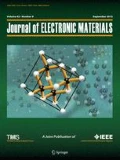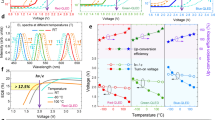Abstract
In this study, we simulate the transient electroluminescence (EL) in organic light-emitting diodes. The forming mechanism of transient EL spikes is discussed in detail. After applying a voltage pulse, the remaining mobile charges drift to the opposite trapped charges and lead to an increase in the exciton recombination rate, which corresponds to the EL spike phenomenon. We observe an EL spike in a solution-processed 2,4,5,6-tetrakis(carbazol-9-yl)-1,3-dicyanobenz-ene(4CzIPN)-doped emitting device, in which 4CzIPN acts as an electron trapping center and confines the electrons within the emitting layer. To further study the effect of the mobility on the EL spike, we simulate it at different electron/hole mobilities. The results show that increasing the hole mobility increases the EL spike. Moreover, when the charge mobility is temperature- and electric field-dependent, the simulation results suggest that if the charge mobility is more susceptible to the electric field, then a lower EL spike is observed, whereas with temperature decrease, a longer tailing is noticeable at the falling edge.
Similar content being viewed by others
References
C.W. Tang and S.A. VanSlyke, Appl. Phys. Lett. 51, 913–915 (1987).
F. So and D. Kondakov, Adv. Mater. 22, 3762–3777 (2010).
T. Fleetham, G. Li, and J. Li, Adv. Mater. 29, 7116 (2017).
M.K. Fung, Y.Q. Li, and L.S. Liao, Adv. Mater. 28, 10381–10408 (2016).
Y. Zhao, L. Zh, J. Chen, and D. Ma, Org. Electron. 13, 1340–1348 (2012).
H. Bassler and A. Kohler, Top. Curr. Chem. 312, 1–65 (2012).
K. Cheon and J. Shinar, Phys. Rev. B 69, 201306 (2004).
Y. Luo and H. Aziz, Adv. Funct. Mater. 20, 1285–1293 (2010).
C. Weichsel, L. Burtone, S. Reineke, S.I. Hintschich, M.C. Gather, K. Leo, and B. Lüssem, Phys. Rev. B 86, 075204 (2012).
Q.M. Peng, P. Chen, and F.T. Li, Appl. Phys. Lett. 102, 023301 (2013).
D. Yokoyama, Y. Park, B. Kim, S. Kim, Y.J. Pu, J. Kido, and J. Park, Appl. Phys. Lett. 99, 123303 (2011).
B. Ruhstaller and S.A. Kart, J. Appl. Phys. 89, 4575 (2001).
S. Altazin, S. Züfle, E. Knapp, C. Krisch, T.D. Schmidt, L. Jäger, Y. Noguchi, W. Brütting, and B. Ruhstaller, Org. Electron. 39, 244–249 (2016).
H. Houili, E. Tutiš, H. Lütjens, M.N. Bussac, and L. Zuppiroli, Comput. Phys. Commun. 156, 108–122 (2003).
H. Kageyama, H. Ohishi, M. Tanaka, Y. Ohmori, and Y. Shirota, Adv. Funct. Mater. 19, 3948–3955 (2009).
Z. Gan, R. Liu, R. Shinar, and I. Shinar, Appl. Phys. Lett. 97, 113301 (2010).
R. Liu, Z. Gan, R. Shinar, and J. Shinar, Phys. Rev. B 83, 245302 (2011).
Author information
Authors and Affiliations
Corresponding authors
Ethics declarations
Conflict of interest
The authors declare that they have no conflict of interest.
Rights and permissions
About this article
Cite this article
Xu, K., Hu, S., Hu, J. et al. Numerical Simulation of Mobility Effects on Transient Electroluminescence Spikes in Organic Light-Emitting Diodes. J. Electron. Mater. 48, 838–844 (2019). https://doi.org/10.1007/s11664-018-6772-x
Received:
Accepted:
Published:
Issue Date:
DOI: https://doi.org/10.1007/s11664-018-6772-x




